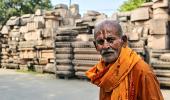'He also granted the temple freedom from all taxes and decreed that no one could litigate against it ever.'
A fascinating glimpse from Vikrant Pande And Neelesh Kulkarni's In the Footsteps Of Rama: Travels with the Ramayana.
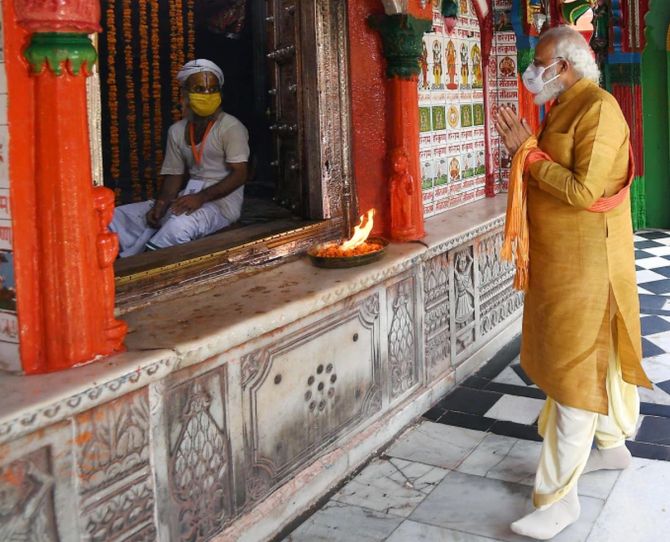
The crow knew the Lord had come!
Not only did he know when the Lord had come before, but he also knew when he would come again.
Over thousands of years and as many lives, Bhushundi the crow, or Kak Bhushundi alone had the blessing which enabled him to flit between the past, present, and the future, to witness whatever stage of Ram's life that he chose to – even before it had occurred, or much after it had.
His devotion to Ram ensured that every time Ram chose to be on Earth, he would be with him.
Cursed by Lord Shiva to turn into a crow for a thousand lifetimes for having shown disrespect towards his guru, Rishi Lomash, Bhushundiwas later given the boon of being able to live across time and space by Shiva himself.
He was to be immortalised as a sage whose name would be taken whenever the Lord Vishnu incarnated as Ram.
For, he was the first to recite the Ram Kathaand had narrated it to the Lord Shiva himself.
It is said that both he and Shiva danced on the streets of Ayodhya the day Ram was born.
Then there was the vanar, born of the wind god himself, who flew to grab the sun when he was just a toddler, and was blessed with unrivalled and unparalleled strength and with intellect the likes of which was never seen before and who yet roamed the jungles of Kishkindha as a pariah with his banished king, till he met Ram.
His devotion to the lord would make him immortal, and ensure that whenever Ram's name was taken on Earth, he would be there to hear it.
We begin our journey to trace Ram's pursuit of dharma, that untranslatable word whose closest translation is a duty, with Ayodhya.
There was no way we could have found Kakabhushundi the crow to seek his blessings for our quest -- he could be anywhere in one of his thousand lives flitting back and forth to be with Ram whenever he takes birth but we could surely seek the blessings of the vanar.
It is he who sits on Ayodhya's highest point, protecting the citizens of Ram's capital and blessing those who try to walk Ram's path.
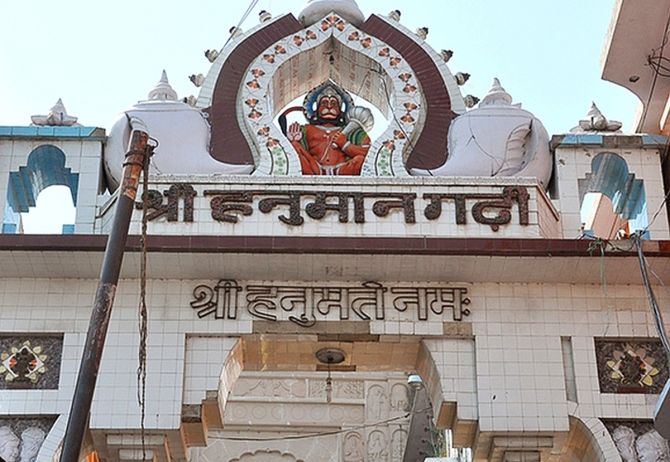
The Hanuman Garhi temple is a mini fortress as we look up from its base.
It is, as the name indicates, solidly built; it has a huge gate and turrets guarded by canons, fourteen in all.
We walk up seventy-six steps to reach a gate that overlooks the city, quite befitting its occupant's role as protector, a responsibility given to him by the Lord himself.
The gate leads to another a little higher up, approached under a covered walkway with rooms on both sides bearing the names of the various pundits who have the hereditary rights to conducting the rituals here.
After another ten steps, the walkway opens up into a courtyard, in the middle of which stands the Hanuman temple.
The temple is smaller than we expected, its sanctum sanctorum about twenty feet on all sides with a corridor running around it.
A raised and the covered platform runs along the sides of the courtyard, and in one spot it is shaped like a chair with silk cushions on it.
We are told this is the gaddi of the head mahant, Bab Prem Das.
The temple is unique in its portrayal of Hanuman.
Here he does not hold a mace or a mountain; he is neither angry nor is he tearing open his chest to prove his devotion.
Instead, here he is quiet, serene, and gentle. The idol itself is not one of the giant imposing ones we see elsewhere.
At Hanuman Garhi he sits upon a throne, befitting his role as Lord Protector of Ayodhya.
There is the usual hustle and bustle round the sanctum sanctorum, with a sizeable police presence, though all the officials are barefoot to maintain the temple's sanctity.
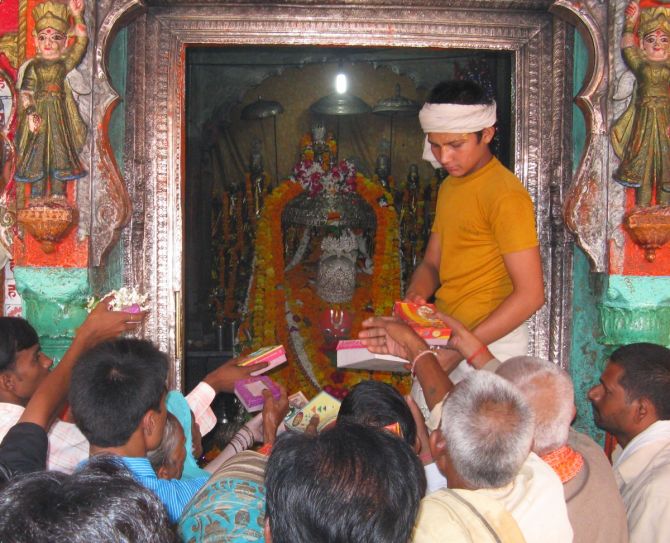
We seek out Baba Prem Das, who we are told had just retired for lunch. We send him a message and he asks us in and blesses us when we tell him about our pursuit.
A simple and slightly corpulent man, he sits upon a wooden bed in a dark room with only a small window for ventilation. We sit on the floor after touching his feet.
'Do you know who built this fortress?' he asks and then continues without waiting for us to reply.
'It was a Muslim ruler. And not only did he build the fort, he also granted the temple freedom from all taxes and decreed that no one could litigate against it ever.' Seeing the incredulity on our faces, he tells us a story:
The nawab had given up all hope! Abdul Manor Khan Safdarjung, the second Nawab of Oudh, had tried every known medicine to cure his son and heir of leprosy, but nothing had worked. The haqeems, vaids and even the local English doctor he had called to his court couldn't find a cure.
'If I may make a suggestion, Huzoor,' ventured his Hindu wazir, 'we could take Shahzada sahib Bahadur to the temple in Ayodhya. The Lord has been known to perform miracles.'
The Hanumangarhi temple was just an idol on a hillock at the time. Bereft of options, and have tried everything else, the Nawab reluctantly agreed.
'What brings you here?' asked Mahant Abhay Das, the caretaker and priest of the idol, when the Nawab arrived.
'I have come because all else has failed. My only son...' the Nawab could not continue as he pointed at him, sobs racking his body. 'Ah, just this,' consoled Mahant Abhay Das and, taking some sacred ash from the temple, smeared it all over the Shahzada.
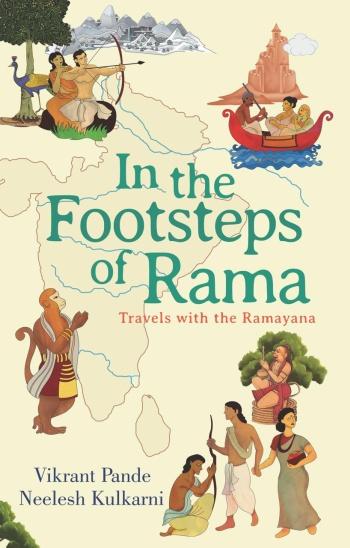
The Shahzada was cured and an ecstatic Nawab offered Mahant Abhay Das anything he wished for.
'I am already a servant of someone who can give me all the three worlds if I want them,' said the priest. 'What is that you can give which HE can't?
On the insistence of the Nawab, he relented and asked that a fort be built to house the Lord Hanuman.
'The temple was finally completed in 1797, in the reign of Nawab Asaf-udDaulah, the grandson of the Nawab who started the construction,' the mahant concludes.
We ask him whether Kakabhushundi recited the Ramayan first.
He laughs. 'Kakabhushundi doesn't find a mention in Valmiki's Ramayan, but Tulsi Das allots him a significant role.
In the Adhyatma Ramayan, the story is first told to Parvati by Shiva, who states it was told to him by Kakabhushundi.
Some people do believe that the Ramayan told to Garuda by Kakabhushundi was the first Ramayana, and thereafter came the Adhyatma Ramayana, both before the birth of Ram.
The Valmiki Ramayan was based on the story told by Narad to Valmiki only later since Valmiki was a contemporary of Ram.
'But does it really matter? Is it not important that the Lord's story has been told and retold so many times in so many ways and languages while the essence has remained intact? You will hear many versions of the Ramayan in your quest, and you will visit temples dedicated to him in various stages of his life.
'His images will vary -- Ram as lalla, the child, and as raja, the king, in Ayodhya; the vanvasior forest dweller Ram in Chitrakoot and Dandakaranya and the virahi missing his wife on the journey to Hampi, and thereafter, as the kodanddhari or the archer. But remember, his essence remains the same.'
'As you leave, take a look at the mosque on the rear. It has always been a part of the temple. When its roof caved in, we got it repaired from our temple funds and threw it open to our Muslim brethren to pray.'
We wonder if it is his wisdom we carryback or his tolerance and large-heartedness, as we begin walking the path of Ram.
Excerpted from Vikrant Pande And Neelesh Kulkarni's In the Footsteps Of Rama: Travels with the Ramayana with the author's kind permission.
Feature Presentation: Rajesh Alva/Rediff.com
